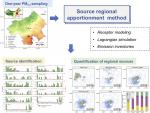摘要:
Identifying and quantifying the major sources of atmospheric particulate matter (PM) is essential for the development of pollution mitigation strategies to protect public health. However, urban PM is affected by local primary emissions, transport, and secondary formation; therefore, advanced methods are needed to elucidate the complex sources and transport patterns. Here, an improved source apportionment method was developed by incorporating the receptor model, Lagrangian simulation, and emissions inventories to quantify PM2.5 sources for an industrial city in China. PM2.5 data including ions, metals, organic carbon, and elemental carbon were obtained by analyzing 1 year of sampling results at urban and rural sites. This method identified coal combustion (30.64%), fugitive dust (13.25%), and vehicles (12.51%) as major primary sources. Secondary sources, including sulfate, nitrate, and secondary organic aerosols also contributed strongly (25.28%–30.76% in total) over urban and rural areas. Hebei Province was the major regional source contributor (43.05%–57.51%) except for fugitive dust, on which Inner Mongolia had a greater impact (43.51%). The megacities of Beijing and Tianjin exerted strong regional impacts on the secondary nitrate and secondary organic aerosols factors, contributing 11.32% and 15.65%, respectively. Pollution events were driven largely by secondary inorganic aerosols, highlighting the importance of reducing precursor emissions at the regional scale, particularly in the Beijing–Tianjin–Hebei region. Overall, our results demonstrate that this novel method offers good flexibility and efficiency for quantifying PM2.5 sources and regional contributions, and that it can be extended to other cities.
访问链接

